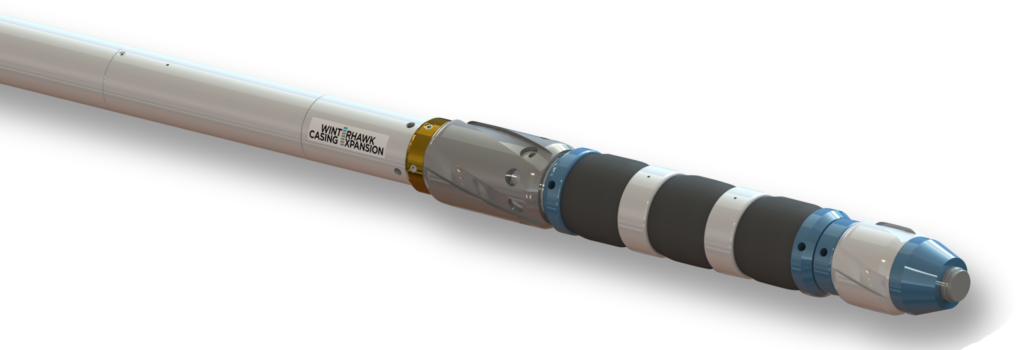In 2016 Winterhawk began developing a revolutionary and patented method to safely and effectively expand casing and other heavy-walled tubulars inside of wellbores.
Using the Casing Expansion Tool (CET), casing can now be used to improve annular integrity, not just to serve as a barrier between the inside and outside of the wellbore.
- Materially reduce vertical communication of gas or liquids in the annulus to address methane flows to surface or interzonal communication
- Return deformed casing to circularity in high-angle and horizontal applications without loss of integrity associated with milling or mechanical swaging
- Expand heavy-walled tubulars for high-temperature, steel-on-steel seals or improve sealing on liner tops, liner hangers or casing patches
When used with remedial cementing, the CET functions as an external casing packer to ensure cement flows to where it is needed, not where annular and formation conditions force it to go.
Winterhawk’s casing expansion tools have been set, released and retrieved intact in dozens of varying wellbore applications.
- The three-element assembly generates 12 or more expansions in a wellbore in one trip in the hole
- The CET has successfully achieved 24 expansions in a single wellbore in two trips in the hole in less than one day of operating time
The question is not if Winterhawk’s CET works. The question is what wellbore problem do you want solved, and what is your ideal desired outcome?
CET APPLICATIONS
|
Historically, the sole purpose of oil and gas wellbore casing is to provide a secure conduit for the production of hydrocarbons to surface, retain the integrity of the borehole through native rock, and to prevent communication between the outside of the casing (annulus) with the inside of the casing in either direction except as required for hydrocarbon production, injection or disposal. Over time and for a variety of reasons, the cement seal in the casing annulus breaks down allowing vertical communication of natural gas or fluids. This can result in unwanted and undesirable interzonal communication which can interfere with production efficiency or result in methane leakage to surface, an operational and environmental hazard. CET uses powerful, hydraulically controlled casing expansion to expand casing in a uniform manner without damaging it to create a seal in the annulus or reseal leaking cement. Of significant importance for the long-term integrity and operational effectiveness of the wellbore, controlled CET does not put holes in the casing nor restrict the normal use of the wellbore. Current methods of re-sealing the casing annulus involve perforating, puncturing or even removal by section milling intervals of casing. Should the remedial cementing that take place thereafter fail, the wellbore suffers a permanent loss of casing sealing integrity. |




